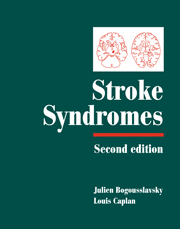Book contents
- Frontmatter
- Contents
- List of contributors
- Preface
- PART I CLINICAL MANIFESTATIONS
- 1 Stroke onset and courses
- 2 Clinical types of transient ischemic attacks
- 3 Hemiparesis and other types of motor weakness
- 4 Sensory abnormality
- 5 Cerebellar ataxia
- 6 Headache: stroke symptoms and signs
- 7 Eye movement abnormalities
- 8 Cerebral visual dysfunction
- 9 Visual symptoms (eye)
- 10 Vestibular syndromes and vertigo
- 11 Auditory disorders in stroke
- 12 Abnormal movements
- 13 Seizures and stroke
- 14 Disturbances of consciousness and sleep–wake functions
- 15 Aphasia and stroke
- 16 Agitation and delirium
- 17 Frontal lobe stroke syndromes
- 18 Memory loss
- 19 Neurobehavioural aspects of deep hemisphere stroke
- 20 Right hemisphere syndromes
- 21 Poststroke dementia
- 22 Disorders of mood behaviour
- 23 Agnosias, apraxias and callosal disconnection syndromes
- 24 Muscle, peripheral nerve and autonomic changes
- 25 Dysarthria
- 26 Dysphagia and aspiration syndromes
- 27 Respiratory dysfunction
- 28 Clinical aspects and correlates of stroke recovery
- PART II VASCULAR TOPOGRAPHIC SYNDROMES
- Index
- Plate section
15 - Aphasia and stroke
from PART I - CLINICAL MANIFESTATIONS
Published online by Cambridge University Press: 17 May 2010
- Frontmatter
- Contents
- List of contributors
- Preface
- PART I CLINICAL MANIFESTATIONS
- 1 Stroke onset and courses
- 2 Clinical types of transient ischemic attacks
- 3 Hemiparesis and other types of motor weakness
- 4 Sensory abnormality
- 5 Cerebellar ataxia
- 6 Headache: stroke symptoms and signs
- 7 Eye movement abnormalities
- 8 Cerebral visual dysfunction
- 9 Visual symptoms (eye)
- 10 Vestibular syndromes and vertigo
- 11 Auditory disorders in stroke
- 12 Abnormal movements
- 13 Seizures and stroke
- 14 Disturbances of consciousness and sleep–wake functions
- 15 Aphasia and stroke
- 16 Agitation and delirium
- 17 Frontal lobe stroke syndromes
- 18 Memory loss
- 19 Neurobehavioural aspects of deep hemisphere stroke
- 20 Right hemisphere syndromes
- 21 Poststroke dementia
- 22 Disorders of mood behaviour
- 23 Agnosias, apraxias and callosal disconnection syndromes
- 24 Muscle, peripheral nerve and autonomic changes
- 25 Dysarthria
- 26 Dysphagia and aspiration syndromes
- 27 Respiratory dysfunction
- 28 Clinical aspects and correlates of stroke recovery
- PART II VASCULAR TOPOGRAPHIC SYNDROMES
- Index
- Plate section
Summary
Introduction
The regular recurrence of aphasic syndromes, especially with strokes, has formed the basis of the cortical localizationist models and has provided clinicians a solid foundation for diagnosis and prognosis. Approximately 25% of stroke patients have significant aphasia (Leske, 1981), making this a common neurological and rehabilitation issue. Broca (1861) established the importance of the left hemisphere in language. Meynert (1867/1868) is credited with the motor sensory dichotomy of cortical function and also with recognizing the accompanying anteroposterior anatomical distinction. Wernicke (1874), subsequently, extended the description of aphasic syndromes including comprehension deficit, on the basis of this motor–sensory dichotomy. Upon these foundations, a number of aphasic syndromes have been described subsequently. The taxonomy of these syndromes has been much debated, but in Table 15.1 the most commonly accepted classification and terminology are summarized. The issue of specialized language cortex, functionally unique and anatomically localizable, similar to the primary motor or visual cortex, has become an important question for research. The existence of such a language cortex is supported by the large number of persisting aphasic patients and the anatomical and physiological evidence for networks for language output and comprehension. The characteristics of such networks can be summarized as: (i) a function is represented at multiple sites, therefore lesions from multiple sites can produce a similar deficit, (ii) each area may belong to several overlapping networks, therefore a lesion in a single area often produces multiple deficits, and (iii) severe and lasting deficit of function occurs when all or most structural components of a network are involved.
- Type
- Chapter
- Information
- Stroke Syndromes , pp. 211 - 221Publisher: Cambridge University PressPrint publication year: 2001
- 2
- Cited by



